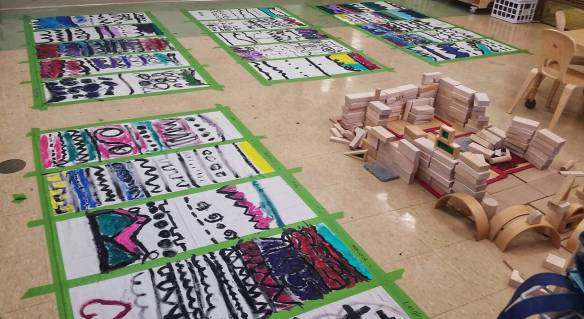Merriam-Webster’s sixth definition of setup is “the manner in which the elements or components of a machine, apparatus, or system are arranged, designed, or assembled.”
I love to remind myself of this definition while I’m going about my classroom setup. I am designing a system in which I, and my students, colleagues, and parents, will work, create, play, and learn. If I’m any example, creating a classroom system requires a lot of thought, reflection, iteration, sweat, and muscle!
As I worked, thought, and sweated, I reminded myself of the truth about myself and my students. We are “rich in potential, strong, powerful, competent” (Loris Malaguzzi quoted in The Hundred Languages of Children, 2nd addition, p. 275). I also thought back to my MA research where I considered the environment that might best support creativity and academic excellence.
I read so many thought provoking things as I researched for my MA. I synthesized them in an article in Creative Education. If I were writing my dissertation, or the article now, I think I might title it Managing the Classroom for Creative and Cognitive Excellence. I want my classroom setup to support creative excellence, and cognitive excellence. To do that, it has to include and support the 6 elements of Teresa Amabile’s KEYS I adapted for classroom management in Managing the Classroom for Creativity:
- Freedom which enables and and encourages ownership, motivation, and engagement of all the learners.
- Positive challenge which helps everyone know the tasks/skills they engage in are important and valuable.
- Supervisory Encouragement which values work and thought, and encourages inquiry and exploration.
- Work group support which encourages the generation and exchange of new ideas.
- Easy access to sufficient resources.
- Organizational Support of our shared vision and an infrastructure that enables and empowers everyone in my learning space.
I’ve finished my initial classroom set up, and am super happy with the result. There is more work to be done, but I’m ready for my learners to join me in the space.
In addition to including the 6 elements listed above, I worked on including more visibility this year. I was mindful of balancing beauty and utility. I wanted our work, vision, thought, prototypes, iterations and our creative and cognitive “mess” to be visible. It adds a richness to the space — telling our story while increasing curiosity, inquiry, wonder, learning, understanding, creativity and excellence!
Here are a few photos with my reflections.
Last year our maker projects where stored in a classroom cabinet. This year, some awesome maintenance people ripped out the cabinet, and I replaced it with this open shelving unit. The wall behind and beside it is covered with a large art piece my students made last year. (How awesome is that?!!!) The use of that artwork, the trays for student work, and the words on the front of the shelving unit let everyone know these things are valued and supported.

A second smaller shelving unit — on the coolest, gigantic wheels — keeps our tools neat and easily accessible. There’s opportunity for remarkable exploration and learning through the use of these tools.

The maker trolley has always been a part of the makerspace, but this year I am repurposing the back to hold more materials, and storing our large item bins in the open. I am hopeful this will increase use and understanding.

The two classroom easels provide opportunities for creative art experiences outside the regular art curriculum. The second is actually a double easel – fabulous for conversation and inspiration! I love leaving the dried paint on the easels. It adds an element of beauty and history to the space, and allows for freedom as one paints.
I’m thinking about the resources I have that might enable me to store paper beneath the easels — enabling the artists to be autonomous in their work. I have some ideas I’m going to try this week.

I love the connection between my learners’ art experience and mine (the watercolors are my work). I also like the suggestion of a connection between painting, shapes, blocks and building.

Print is plentiful and purposeful in my learning space. I want my students to read the room and learn. I want them to become more skilled at letter recognition and use, and to be inspired — to see, read, absorb, and live, what is important.



I love all the little print treasures in my space, so it’s nearly impossible to choose a favorite. However, I am enjoying this one quite a bit! I wonder what it will evoke or awaken in those who see it. For me it stirs up joy, possibility, positivity, and continuing even when obstacles arise.

And this, partially hidden gem, out of the way of traffic, is a message from me, to me. “Be a superhero every day. The kids and the world deserve it!”

All the best to all my fellow educators. Arm yourself with another Malaguzzi truth “Nothing without joy!” and have a fantabulous year!
NOTE:
Whenever I write, I think of all the remarkable people I’ve read, talked with, and researched . I think about adding tons of links to each post. Instead, I offer my deep gratitude to all those who informed my research and learning, and remind my readers there is a great bibliography at the end of my Creative Education article.
Save



















